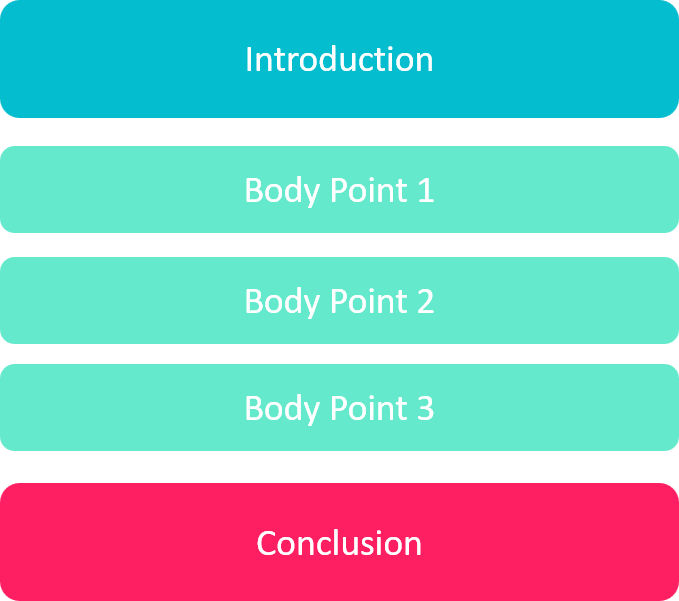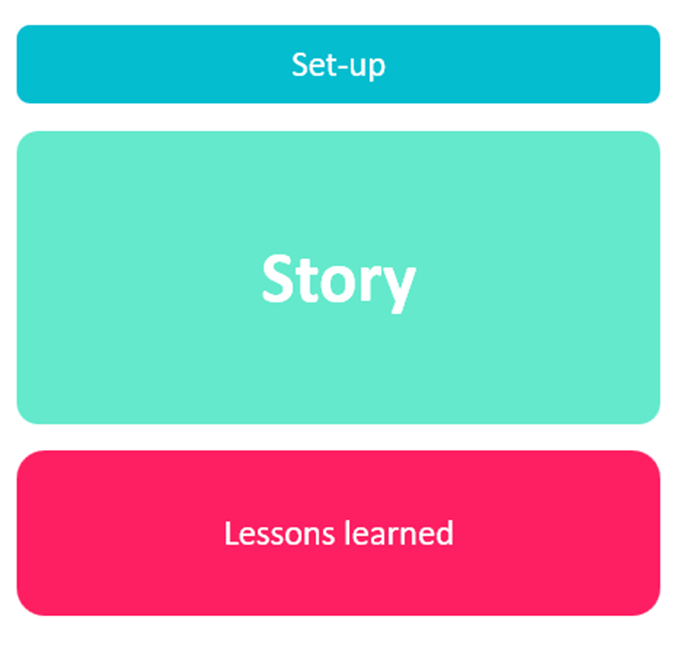The Narrative Presentation Style

Everyone loves to hear a great story and that’s why the narrative presentation style is one of the most powerful ways to deliver a talk and make a point.
In a narrative presentation, the story is more than just a simple anecdote. Instead, it forms the main basis of the presentation.
A standard presentation looks like this:

A narrative presentation is different. It looks something like this:

Example
Let’s use Mark Bezos’ TED Talk as an example. The title of his talk is “A life lesson from a volunteer firefighter”:
The set-up
Instead of a traditional introduction, we set up the story we’re going to tell: the background, the reason for telling the story and so on.
Here is the set-up from the example above (found at the beginning of the talk):
Back in New York, I am the head of development for a non-profit called Robin Hood. When I'm not fighting poverty, I'm fighting fires as the assistant captain of a volunteer fire company. Now in our town, where the volunteers supplement a highly skilled career staff, you have to get to the fire scene pretty early to get in on any action.
With this style of presentation, we don’t tend to preview what we are going to talk about – it would ruin the story. Bezos doesn’t talk about the lessons he learned. He’ll leave that part until the end of the talk. He gives just enough details to capture your interest.
The set-up can be shorter than a typical introduction, so that we can get straight into the story.
The story
With a narrative presentation, the story will be the main part of the presentation. After all, the story is the fun part, the part that your audience will remember!
The lesson(s) learned
After softening the audience with your story, it’s time to teach them what you learned.
The lesson learned from the story acts as the conclusion or ending to your talk. However, you should think about making this part of your talk a little longer than a typical conclusion. After all, the lesson that you want people to learn from your story is important; it’s why you’re giving the talk.
Here is Bezos’ lessons learned:
In both my vocation at Robin Hood and my avocation as a volunteer firefighter, I am witness to acts of generosity and kindness on a monumental scale, but I'm also witness to acts of grace and courage on an individual basis. And you know what I've learned? They all matter. So, as I look around this room at people who either have achieved, or are on their way to achieving, remarkable levels of success, I would offer this reminder: don't wait. Don't wait until you make your first million to make a difference in somebody's life. If you have something to give, give it now. Serve food at a soup kitchen. Clean up a neighborhood park. Be a mentor.
Not every day is going to offer us a chance to save somebody's life, but every day offers us an opportunity to affect one. So, get in the game. Save the shoes.
Notice that he includes a call-to-action.
Can a narrative style be used in a business presentation?
Absolutely!
Let’s imagine that you are promoting medical products. What would be more powerful than a story about how your products changed a patient’s life?
Or, imagine that you are talking about crisis management. A story about how your company managed a crisis such as a cyberattack or a political scandal would be very powerful.
In a business presentation, your lessons learned and call-to-action could be a little longer still – perhaps up to 30% of the total presentation.
Alternatively, you could use a hybrid-style presentation, where you use a narrative together with a more traditional structure.
What mistakes do people make with a narrative style presentation?
The main mistake that I see with this style of presentation is not enough focus on the last part. The lesson that you want to impart is very important. Be sure to explain it in detail and spend enough time on it.
Your challenge
Do you have a great story that teaches a lesson or promotes an idea or product? If so, I challenge you to create a presentation around it.